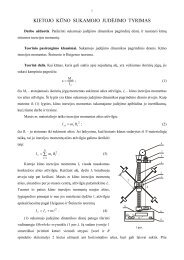PROCEEDINGS OF THE 7 INTERNATIONAL ... - Fizika
PROCEEDINGS OF THE 7 INTERNATIONAL ... - Fizika
PROCEEDINGS OF THE 7 INTERNATIONAL ... - Fizika
Create successful ePaper yourself
Turn your PDF publications into a flip-book with our unique Google optimized e-Paper software.
T. Landberg et al. / Medical Physics in the Baltic States 7 (2009) 43 - 51<br />
For each volume defined, a color code is proposed to<br />
assure clarity of interpretation.<br />
GTV: Gross Tumor Volume (dark red)<br />
CTV: Clinical Target Volume (pink)<br />
ITV: Internal Target Volume (dark blue)<br />
PTV: Planning Target Volume (light blue)<br />
OR: Organ at Risk (dark green)<br />
PRV: Planning Organ at Risk Volume (light green)<br />
Landmarks (black)<br />
Fig. 4. Schematic representation of the different<br />
volumes/margins.<br />
Note:<br />
(1) The Internal Margin may be asymmetrical.<br />
(2) Like the Internal Margin, the Set-up Margin may also<br />
be asymmetrical.<br />
(3) To delineate the PTV, the IM and SM are not added<br />
linearly (since this could result in an excessively<br />
large PTV), but are combined (for explanation, see<br />
text). The PTV is thus smaller than if one would<br />
simply have added the IM and SM linearly.<br />
(4) For Organs at Risk (OR), margins are added in the<br />
same way as for the PTV.<br />
(5) The PTV and PRV may or may not overlap.<br />
Note that when the Treated Volume is made smaller by<br />
use of many beams (e.g. in IMRT) the Irradiated<br />
Volume gets larger.<br />
Scenario A.<br />
A margin is added around the Gross Tumor Volume<br />
(GTV) to take into account potential “subclinical“<br />
invasion. The GTV and this margin define the Clinical<br />
Target Volume (CTV).<br />
In external beam therapy, to ensure that all parts of the<br />
CTV receive the prescribed dose, additional safety<br />
margins for geometric variations and uncertainties must<br />
be considered.<br />
48<br />
An Internal Margin (IM) is added for the variations in<br />
position and/or shape and size of the CTV. This<br />
defines the Internal Target Volume.<br />
A Set-up Margin (SM) is added to take into account all<br />
the variations/uncertainties in patient-beam<br />
positioning.<br />
The CTV combined with the IM and the SM define the<br />
Planning Target Volume (PTV) on which the selection<br />
of beam size and arrangement is based.<br />
Fig. 5. Schematic representations of the relations<br />
between the different volumes (GTV, CTV, PTV, and<br />
PRV) in different clinical scenarios.<br />
Scenario B.<br />
The simple (linear) addition of all factors of geometric<br />
uncertainty, as indicated in scenario A, often leads to<br />
an excessively large PTV, which would be<br />
incompatible with the tolerance of the surrounding<br />
normal tissues.<br />
In such instances, instead of adding linearly the<br />
Internal Margin and the Set Up Margin, compromise<br />
2<br />
combinations are used, e.g., ∑ σ formalism. This<br />
quantitative evaluation is only relevant if all<br />
uncertainties, and their σ, are known, i.e. in a few<br />
sophisticated protocols.<br />
Scenario C.<br />
In the majority of the clinical situations, a “global“<br />
safety margin is adopted. In some cases, the presence<br />
of Organs at Risk dramatically reduces the width of the<br />
acceptable safety margin (e.g., presence of the spinal<br />
cord, optical nerve, etc.). In other situations, larger<br />
safety margins may be accepted.<br />
Since the incidence of subclinical invasion may<br />
decrease with distance from the GTV, a reduction of<br />
the margin for subclinical invasion may still be<br />
compatible with chance for cure, albeit at a lower<br />
probability rate.<br />
It is important to stress that the thickness of the<br />
different safety margins may vary with the angle from<br />
which one looks at the PTV (e.g., bony structures or








